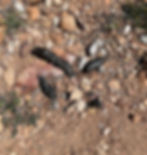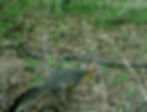Do You Know Your Scat?
- Cholla Rose Duir
- Apr 25, 2023
- 2 min read
Updated: Nov 20, 2023
The Borderlands Wildlife Preserve is home to a wide array of wild animals. Many animals are nocturnal, elusive, or extremely fast, making them hard to see on your average daytime hike. I can guarantee you will see scat on every trail within the BWP. It is everywhere if you take the time to look down while walking or riding the trails. Even the beautiful photos of wildlife you frequently see on our social media sites start with scat. We use scat and tracks to determine the best locations for our wildlife trail cameras.

Identifying scat can be fun if you don't take it too seriously. Know that variations in diet can cause a considerable variation in size, shape, and color, making identifying scat challenging. Like everything else, practice can make perfect! There are trackers worldwide living traditional lifestyles who can identify scat with great accuracy. However, for those of us living modern lifestyle and not as familiar, there are a few identifying characteristics that can be fun to look for when out in nature. But, it is also essential to safely interact with scat. Please remember not to touch scat with bare hands and try not to breathe in dry scat when you are near it.
Basic shapes are the first thing to identify. Tubes and cylinders generally belong to fruit or meat eaters, such as coyotes, bobcats, and javelina. Pellets generally belong to rabbits and ungulates such as cottontail rabbits, mule deer, jackrabbits, and white-tailed deer. Squirts and blobs are frequently coming from birds, but depending on mammals' health and diet, they can sometimes belong to anybody.

Further breaking down shapes can be twists, tapered or blunt ends, and vertical or horizontal segments. Generally, twisted scats belong to the dog or weasel family. Dogs and weasels also tend to have tapered ends, while cats and bears have more blunted ends. Cats also tend to have segmented scats that break into pieces, while dogs have a rope-like shape that folds back on itself.
Color and content can also help determine what species left the scat. For example, a dark scat indicates a recent meat meal. Maybe the scat also has fur and blunted ends. You could be looking at a cat scat. If upon further inspection you find woody material and seeds, it could be javelina scat which also frequently is a dark color from vegetation and has fur in it from their behavior of grooming themselves and other herd members. The vegetative material would rule out it is from a cat, an obligate carnivore. Older scat can turn white with a white powdery substance indicating organ and meat tissue.

Knowing your scat can be a fun way to interact with the world around you, and trust me, your friends will have so many questions about so much scat. It is everywhere, after all, and easy to spot. If you want to learn more about identifying scat, I recommend checking out or purchasing a book on scat. One of my favorites is Mammal Tracks & Sign: A Guide to North American Species, authored by Mark Elbroch. Enjoy!


